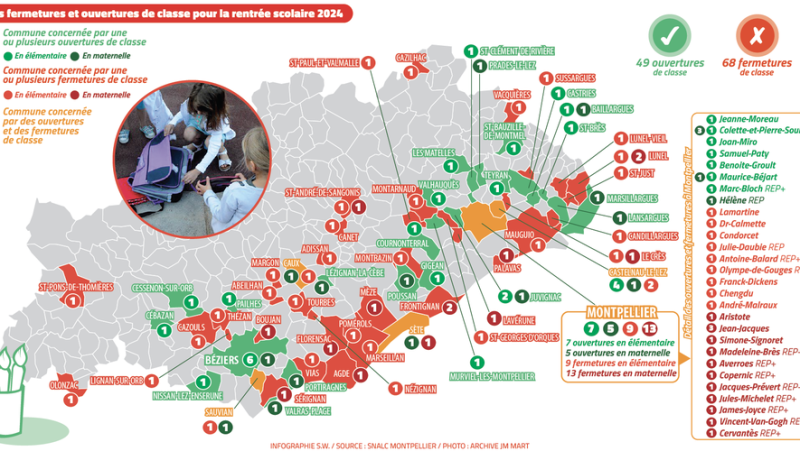Openings and closings of classes at the start of the 2024 school year in Hérault

La nouvelle carte scolaire présentée la semaine dernière en préfecture.
The September school map in Hérault was presented to the prefecture a few days ago against a backdrop of a drop in the number of students. It provides for a reduction of 19 classes in first degree, i.e. 68 closures and 49 openings.
The school map for the 2024 school year for Hérault was presented on February 9 at the prefecture. This table provides an overview of the openings and closures of classes by municipality and is based on forecasts of numbers welcomed next September. It also takes into account the priorities determined by the ministry such as the capping of 24 students for all major sections, CP and CE1, the continuation of the doubling of classes in major sections located in priority education zones, the implementation of compulsory education from the age of 3, finally, the progression of the schooling of children aged 2 in the priority districts of the city…
An average of 22.5 students per class
For the second consecutive year, the number of children welcomed should be down slightly, estimated at 286 students.
The academic director of the National Education Services (Dasen) of Hérault, Catherine Côme, however, highlights an "improvement in the rate of ;rsquo;framing" with the increase of 12 full-time equivalents across the entire territory. "In two years, a positive allocation of 34 FTEs for a reduction of 972 students" she specifies. According to its data, the average number of students per class will decrease at the start of the school year with a ratio of 22.5 children.
The new map provides, overall, for the closure of 68 classes but the opening of 49 others, i.e. a negative balance of 19 closed classes, a rehabilitation widely distributed across the territory. At the end of the discussions, in the Departmental Council of National Education on February 9, two closure measures were however canceled in Montarnaud and Vacquières.
This reduction, however, remains strongly denounced by the trade union organizations which voted unanimously against this new card. "We could and should have taken advantage of the slight drop in demographics to significantly reduce the number of students per class, to reconstitute Rased (help network for students in difficulty) to resume the policy of more teachers than classes" writes Snalc, the national union of high schools, colleges and schools. "We are well aware that there is a drop in numbers in the department but we would have liked this to be an opportunity to improve the learning conditions of the students and the working conditions of teachers" adds Anne Peytavin, the departmental secretary of the FSU for the first level.
Inclusion: two additional Ulis
The new school map provides for the creation of two Ulis classes (localized units for educational inclusion), one in Castelnau-le-Lez (Jacques-Chirac primary school), and the other in a municipality which remains to be specified. An autism class should also be created at Ganges primary school. In the department, around a hundred students would need to have a place in Ulis. "We are well below the resources we would need. The kids are poorly supported and we end up in situations of great suffering, for the student, his classmates, the teacher and the AESH"  ;observe the teacher representatives.
Adjustments to come
This school map must still be subject to review next June, for classes with tangent numbers, taking into account population movements linked, for example, to the delivery of housing in a municipality and, finally , a final adjustment at the start of the school year in September. The result of a "broad consultation between national education inspectors, school directors and local elected officials"< /em> indicates the academic inspection. "The problem is that Dasen is looking at the figures this year, even if it means reopening next year. It does not look at the medium term and does not take staff into account; teachers who see their classes close must participate in the staff movement. In certain municipalities we would be able to anticipate" deplores Anne Peytavin, unhappy with the dialogue that took place during this development.
“A map too based on numbers”
Anne Peytavin is the departmental secretary of Snu-ipp, the majority union among primary school teachers.
What criticisms do you have of this new school map ?
We are in positive endowment but we do not say that we are based exclusively on calculations and figures. For the cap at 24 in the large section, CP and CE1 we will be at 96% but we are not talking about CE2, CM1, CM2 we are not looking at the average. In reality, on the ground there are classes of more than 30 students. On replacement, one of the national priorities, in Hérault we remain at the same level of staff as for the schooling of under-threes. We are only on display and this school map is only based on figures. We have no management that comes from the field. An academy inspection cannot avoid being on the ground and making an assessment for itself.
The specificities of rural areas are not taken into account enough in your opinion.
We paid attention to schools in rural revitalization zones (ZRR) but in small towns which are not in ZRR, it’s a disaster. Several classes in small primary schools or nursery schools are closed. Colleagues find themselves three classes apart to manage eight levels, it’s a headache. This is why all the organizations spoke out against.
I subscribe to read more




